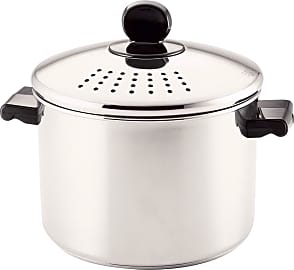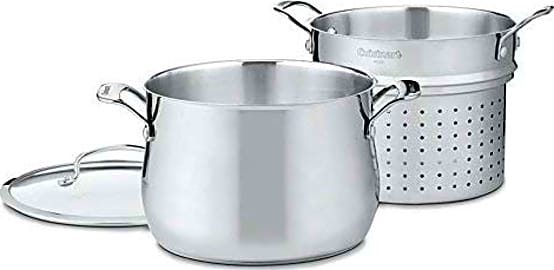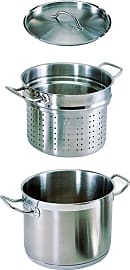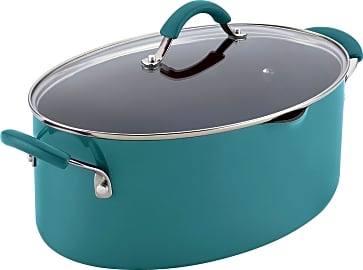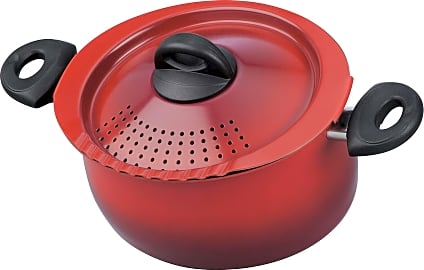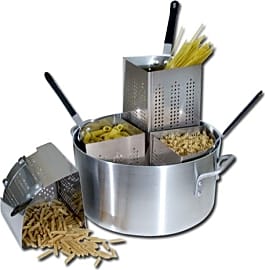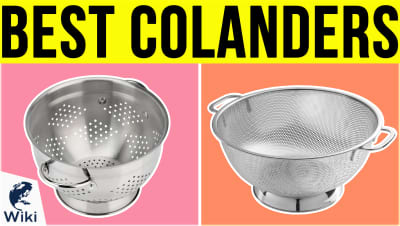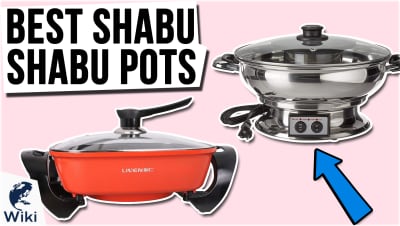The 8 Best Pasta Pots

This wiki has been updated 43 times since it was first published in April of 2015. Whether you’re making a big Sunday meal or a quick weeknight dinner, these pasta pots can take some of the chore out of food preparation, as they let you drain hot water with ease. They’re also useful for boiling potatoes, eggs, corn on the cob, and anything else that requires straining. Some come with colander inserts that are also suitable for blanching and deep frying. When users buy our independently chosen editorial selections, we may earn commissions to help fund the Wiki.
Editor's Notes
July 30, 2021:
Our previous #1, a copper-base model from All-Clad, is no longer available. It's been replaced by the All-Clad Tri-Ply 4807, which is nearly identical anyhow. We also removed a Lagostina model with poor availability that also happened to be nearly identical to the affordable Cuisinart Chef's Classic. The rest of our selections remain the same, including the commercial-favorite Winware 20 Quart that has four separate strainers for making multiple varied dishes at once.
March 11, 2020:
Several high-quality models join our list in this update, in a range of prices, so there’s something to meet every budget. The Lagostina Q55103 replaces another from the same manufacturer that’s no longer available, and this one is compatible with all cooktops, including induction ones, and it can also be placed in the oven at temperatures up to 500 degrees. It’s innovatively designed with a lid featuring two top handles that can serve as a spoon rest while you’re cooking. It also comes with two wooden utensils: a pasta fork and a spaghetti measurer. It also comes with a handy pull-out colander and is made in Italy.
There’s a lot to like about the Cuisinart Chef's Classic, which we added and placed in one of our top spots. Its shiny, mirror-like finish stays intact even after you’ve used it in the dishwasher, freezer, broiler, and oven. Like the Lagostina model, this one comes with a colander insert, but it’s also equipped with a shallow basket that can steam vegetables in the pot while you’re also cooking pasta. The pot features handy measurement markings and a tapered rim to prevent drips. It’s a good value for the price and it’s also backed by a lifetime warranty.
Rather than a colander insert, the Farberware 70755 features a lid with holes in it, so you can quickly and easily pour out the water when your noodles are done cooking. It’s safe for the dishwasher and is available in three sizes, so you can choose the one that’s right for your household, whether you're dining alone or you've got many mouths to feed. Incidentally, it’s also available with a lid without the straining holes.
The Culina Silver and the Pensofal Terre di Siena also leave the list today, as they’re no longer available. While you’re shopping for cookware, if you find yourself in search of a stand-alone strainer as well, check out our well-curated list of best colanders, which features standard, bowl-shaped varieties as well as conveniently collapsible and expandable designs.
Why You Need A Dedicated Pasta Pot
The inserts that come with pasta pots offer a few other surprising benefits.
If you've been grabbing a pot from your standard cookware set to make pasta, I have news for you: you've been doing it wrong. Each pot serves a special purpose, and pasta pots are no different. Most pasta pots come with an insert that stays inside the pot, while you're boiling your water and making your pasta. This insert not only makes your job easier, but it also protects the integrity of your pasta. Without an insert, you have to lug your full pot of hot water and pasta over to the sink, and pour the pasta out into a colander. Then, you have to transfer the pasta once again, this time into your serving bowl. The more times you transfer pasta, the more prone it is to breaking, especially with more fragile pastas like ravioli. Using an insert means you can reduce the number of times the pasta moves from one dish to another, thereby reducing breakage.
If you have weak wrists, you can't afford to not have a pasta pot. Carrying a pot of hot water and pasta to the sink can be too much for your forearms. An insert lets you cut the weight of the entire thing nearly in half, allowing you to first remove just the pasta, and then dump out the water. Another nice perk is that this allows you to let the water cool before pouring it out. How many times have you burnt your wrists while dumping a pot full of hot water and pasta into a strainer? Probably more times than you'd like to admit.
The inserts that come with pasta pots offer a few other surprising benefits. If you like to hold onto your pasta water and use it as a finisher in your pasta sauce, you can do that with a pasta pot. Not so with a regular pot. You lose all your pasta water when you dump out your noodles using a standard pot. These inserts are also great for making broths and stalks. Rather than individually scooping out each chicken bone and vegetable piece, just make your stock using a pasta pot, putting your solid items in the insert, and remove the insert when your liquid is ready.
Myths About Making Pasta, Busted
At first glance, there isn't much that differentiates one pasta from another. But if you've dined at several Italian restaurants, you know that simply isn't true. The flavor and texture of pasta can vary wildly. It's all in the way the chef makes it. You could make yours restaurant-quality, too, if you just stopped believing a few myths. First, if you are adding oil to your water: stop that. We all know that water and oil do not mix, yet we keep putting oil on our pasta and expecting some of our water-based sauces to stick to it. It just won't work. If you twirl your noodle in a puddle of sauce and lift it to your mouth only to find all the sauce has slid off, it's probably because you added oil to your water.
The pasta-sauce rules are extensive, but generally remember that small, shaped pasta like farfalle do well with a textured sauce, such as bolognese.
The second untrue myth is that you should rinse your pasta after straining it. This interferes with your pasta's ability to hold onto sauce. When you rinse your pasta, you remove many of the starches that help it hold onto sauce. If you're rinsing your pasta with cold water, you're making matters worse because, you're cooling down your pasta, and who wants cold pasta? Only rinse your pasta if you plan on making a cold pasta salad. A third damaging myth is that you should strain every last bit of water from your pasta. Keeping a little bit of the pasta water is actually good for your sauce, helping to blend the natural flavor of your noodles with your sauce a little better.
The final myth you need to stop believing is that every pasta shape and every pasta sauce goes well together. They do not and it's important you know that so you don't have an unsatisfactory pasta-eating experience and quit the food altogether. Pasta eaters are actually some of the healthiest people, so do what you can to keep loving the stuff. The pasta-sauce rules are extensive, but generally remember that small, shaped pasta like farfalle do well with a textured sauce, such as bolognese. Tubed pasta like penne do well with chunky sauces. Long noodles thrive with olive oil-based sauce.
What To Look For In A Pasta Pot
When picking out your pasta pot, there are a few features to look for that will make your cooking and dining experience much better. Make sure your pot has a non-stick interior so that your noodles will easily slide off of it when you pour them out. Just look for those that are free of Perfluorooctanoic acid (PFOA), a compound used in the process of making Teflon that has been shown to cause health defects. On another safety note, you'll want a pot with handles that don't heat up, so if you forget to put on your oven mitts, you won't burn yourself.
True pasta gourmands might like a pot that has several inserts, so that you can make various types of pasta at once. This way, you can get your fusilli ready for your pasta salad and your noodles ready for your spaghetti bolognese, all at the same time. These are also helpful when cooking for family members with different taste. Maybe you want whole grain pasta because you've heard it's better for you, while your spouse just wants plain white pasta. Multiple inserts mean you don't have to use multiple pots, and that means less cleanup later.
Make sure to choose a pot made from rust- and warp-resistant materials, as well. You should also consider one that's safe for use with metal utensils, too, so you don't accidentally scratch your pot while trying to steal a taste of the boiling contents. Typically, pots that are made from a combination of stainless steel and aluminum will stand the test of time.



